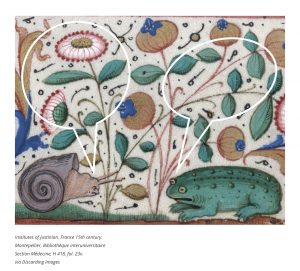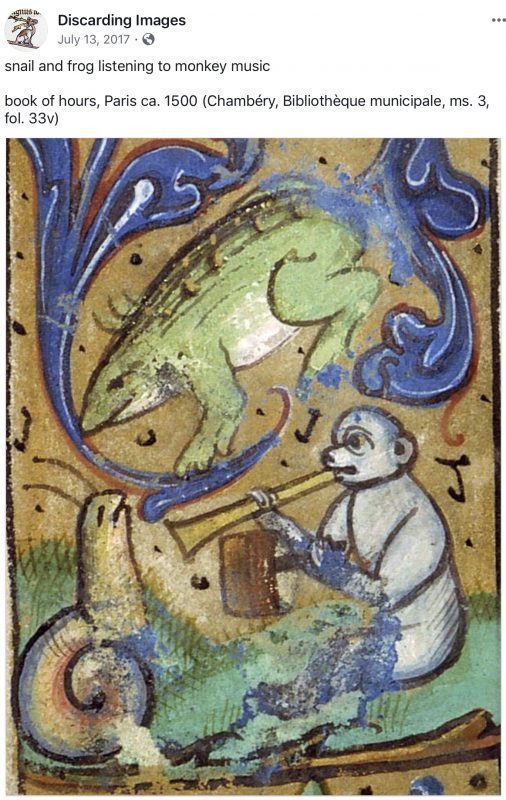
Information from the SYLLABUS:
I. CLASS (20%)
- Attendance, participation, commentary on reading (PRIVATE / CLASS ONLY discussion area, on UBC Canvas): 15%
- Responsible for one discussion session (by group: with group members distributed to circles, preparing background reading as experts; also in a class-only Canvas discussion area): 5%
II. PUBLIC KNOWLEDGE CONTRIBUTION (10%)
- “Humanimals Reading: A Local Bestiary”
Object selection and commentary (individual; may be pseudonymous and/or collaborative; may also overlap with group project work in III below): 10%
The bestiary will be organised in accordance with Marie de France’s Fables and bestiaries. (We’ll work on organisation together.) An object could be an animal, a representation of an animal, an object or idea associated with or made out of animal; it could include digitised manuscripts, MOA inhabitants, live action video, etc. “Local” isn’t necessarily just UBC but is open to student individual interpretations, so as to be true to themselves.
Read more about this assignment here below.
III. PROJECT (40%)
- visit office hours (1) to discuss ideas: 5%
- planning, sketch, draft, methodology, bibliography: 5%
- visit office hours (2) to discuss progress: 5%
- work sample (may be a version of the object commentary in II above, contextualised within your project): 5%
- poster presentation (see IV below)
- final project: 20%
Read more about this assignment here below.
IV. ANTI-EXAM (30%)
- poster presentation of project: 15%
- commentary on at least three other projects, in relation to the course theme and set readings: 15%
Some of these assignments are self-assessed and/or peer-assessed.
More about the PUBLIC KNOWLEDGE CONTRIBUTION:
Critera:
- Independent or in a small group (2-4 people)
- Topics / criteria:
—A description
—in the style of a bestiary or fable-collection entry
—of an animal
—that is from your own local environment: UBC, Vancouver, home, or other definition of your own habitat / ecosystem
—including at least one image: medieval examples could include a manuscript illumination, a painting or sculpture, an everyday object, a building, a map - Form: commentary (written, read and recorded, or otherwise performed and filmed); expected length around 300 words or equivalent (minimum 200, maximum 500) per person
- Submission on (this present) UBC Blogs public course site
- Resources:
- Bestiography
- Guidance: on reading and writing
—about plagiarism (as contrasted with proper citation, WHICH IS ENCOURAGED!!!)
—about style guides (quick version: I don’t mind which system you use provide that you’re consistent in your usage; and your own individual stylishness is far superior to anyone else’s formal rules)
—NB: brilliant commentary does not necessarily involve any “research” in the sense that you may have met in other courses, that is: the reading of or reference to secondary sources (i.e. criticism/commentary written by others, books, journal articles). It can be done entirely from first principles: that is, the combination of a primary text / primary sources (including their representations online, for example in the case of manuscripts in libraries elsewhere and objects in museums), your good reading, and pure reason.
- Your bestiary entry can ALSO be your Project stage 4 (work sample) or a longer version of it: for example, if your final project is a bestiary, or a collection of bestiary entries, or bestiary-related.
- Examples of how this is done in applied practice:
—bestiaries, herbals, and fable-collections from the medieval Romance world (references will be in class notes from week 2 onwards)
—exhibits at the UBC Museum of Anthropology
—and this free multimedia online exhibit (with audio):

More about the PROJECT:
Criteria:
- independent research, critical, or creative project (around 1000 words or equivalent: minimum 750, maximum 1500)
- individual or in a group (2-4 people: then around 1000 words per person—minimum 750, maximum 1500 each—or equivalent)
- in relation to the course theme and central questions:
- = “animal reading”
- + “What does it mean to be an animal? To be a human? And what does reading have to do with anything?”
- and related, at least in part, to at least TWO of the following:
- at least one of the required readings: Marie de France, Lais and Montaigne, Essays
(for example, a Montaigne essay that was discussed in class, or one that was mentioned in a lecture, or one that we didn’t work on in the course) - and/or the Medieval to Early Modern Romance world
(for example, another text, a manuscript, a work of art, a three-dimensional object, an animal (ex. frog) featured in a bestiary or other work in this geographical area; other options may be possible, we’ll discuss this in your meeting with me at stage 1 of the project) - and/or materials (literary or otherwise) from the medieval or other “middle” period in any culture anywhere:
as some cultures consider themselves to be in a middle period (not the beginning of the world, not the end), this could, by other definitions or conventions, be “contemporary”
- at least one of the required readings: Marie de France, Lais and Montaigne, Essays
- form: free, EXCEPT NOT AN ACADEMIC ESSAY:
a research-paper, commentary, Montaignian essay, creative writing (poem, short story, dream-vision narrative, allegory, speculative fiction, alternate history, etc.), multimedia experiment, audio, video, filmed performance, a made object - this could also be a continuation, in greater depth, of your “Humanimals Reading: A Local Bestiary” public knowledge contribution; or further contributions to it, for example more bestiary entries about other creatures
- see also: on reading & writing
- submission type will vary depending on the nature of your project (online, physical object, etc.)
- due date: 5 days after final examination, so that you can integrate any feedback and comments from students in your poster presentation (= the first part of the anti-exam)
